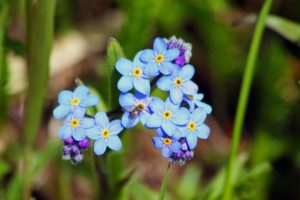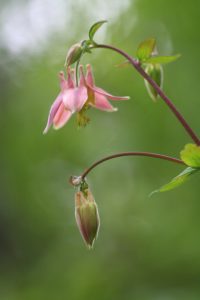Wildflowers, Wistful and Wise
There is a reason that wildflowers evoke flowery, evocative language. On a recent hike through Crow Pass, acres of wild roses filled the air with a scent like sweet honey and raspberries. Each rose’s five pink petals lay open like hands, receiving the kiss of sunshine. Dwarf dogwood bloomed on either side of the trail. Blue bells draped their heads downward, shy maidens of spring. For all the splendor of the wrinkled glaciers we saw, the jagged mountain peaks and the vistas whose scope set our minds to reeling, there at our feet bloomed a profusion of wildflowers as lavish as anything that Alaska offers up during this season abundance.
The names of wildflowers themselves suggest stories and fables. Early in May, when the ground was brown and snow still filled the gullies at Crevasse Moraine trail system, a friend and I noted a splash of green alongside the trail with a small pink flower sporting the spikes of a three-pronged star. A closer look revealed a yellow cup beneath the star, a delicate orchid-looking thing. “Fairy Slipper” the wildflower book back home called them. Did someone once imagine small fairies dancing in the forest this time of year? Did their feathered footsteps awaken the other flowers of spring?
The Forget-me-not’s name comes from a legend in which a medieval knight, picnicking with his true Love, descended the banks of a river to collect the sky-blue flowers he saw on the shore. A flash flood suddenly rushed through and as the young man was swept tragically into the river, he threw the bouquet to his lady on the bank, saying “Forget me not.”
Jacob’s ladder is named not for its showy blue blossom, but for the ladder-like shape of its leaves. Monkshood is aptly named for the profile of its deep purple head. Chocolate lilies look good enough to eat – but smell like stinky feet. And the “wooly lousewort” was named by sheepherders who thought that their fuzzy buds harbored lice. (To me it sounds as if the shepherd was just in a bad mood – since their pink flowers are delightful.)
 This time of year, splashes of blue, pink, purple and yellow fill mountain meadows with a kaleidoscope of color. I think about the science of natural selection and the very specialized purpose of stamens and pistils, of insects and pollination. Yet I cannot help but think of the playfulness of their Creator. Is it not possible that the earth is adorned with certain creatures and plants for the reason that they offer simple pleasures for the senses? Could delight not also be one purpose for their existence?
This time of year, splashes of blue, pink, purple and yellow fill mountain meadows with a kaleidoscope of color. I think about the science of natural selection and the very specialized purpose of stamens and pistils, of insects and pollination. Yet I cannot help but think of the playfulness of their Creator. Is it not possible that the earth is adorned with certain creatures and plants for the reason that they offer simple pleasures for the senses? Could delight not also be one purpose for their existence?
Which brings me to the other reason I love wildflowers. They are simply there. Abundant and generous, they are not a commodity to be harvested, but rather a sweet gift to be savored. Wildflowers stand separate from Alaska’s traditional gathering of fish and game and berries. They do not last long in a vase. They cannot be canned or frozen or otherwise preserved for future use. They are best seen on the days of their blooming, seen in the full blaze of sunshine or in the gentle mist of rain. The only harvest lies in the moment of their beholding. Wildflowers are best cherished the way we ought to gaze upon children, the elderly – and each other. For their simple beauty and for the knowledge that we may treasure them only for a short season. And maybe, if we are lucky, they will change us before they take their leave.